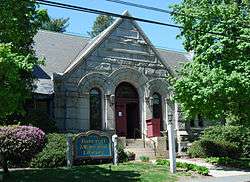Bancroft Memorial Library
Bancroft Memorial Library is the public library serving Hopedale, Massachusetts. It is located at 50 Hopedale Street in the town center, in a fine Romanesque building built in 1898-99 and listed on the National Register of Historic Places.[1]
Bancroft Memorial Library | |
 | |
  | |
| Location | 50 Hopedale St., Hopedale, Massachusetts |
|---|---|
| Coordinates | 42°7′49″N 71°32′30″W |
| Area | less than one acre |
| Architect | C. Walker Howard |
| Architectural style | Romanesque |
| NRHP reference No. | 99000188[1] |
| Added to NRHP | February 12, 1999 |
Architecture and history
The library is located on the west side of Hopedale Street, a short way north of the town common. It is a single-story stone structure, designed by Boston architect C. Howard Walker of the firm Walker & Kimball. It is constructed of pink Milford granite, and was modeled after Merton College Chapel at Oxford. Its entrance is prominently located in a cross-gable projection, set in a round-arch opening flanked by smaller round-arch openings. The interior retains many fine original finishes, include oak ceiling trusses, an oaken circulation desk, and oak partitions in the reading areas that are typical of Gothic churches.[2]
The town of Hopedale's first proper library was established in 1840, and was located in a variety of places, including private residences, churches, and town hall, where it occupied the first floor in 1886.[2] This building was built for the town by Joseph Bubier Bancroft, in memory of his wife Sylvia. Bancroft was an executive with the Draper Company, the town's principal employer,[3] and also represented the town as a selectman and in the state legislature. It was built adjacent to Bancroft's house (which still stands), and was donated to the town upon its completion in 1899.[2]
References
- "National Register Information System". National Register of Historic Places. National Park Service. April 15, 2008.
- "NRHP nomination for Bancroft Memorial Library". Commonwealth of Massachusetts. Retrieved 2018-09-13.
- Joseph B. Bancroft
